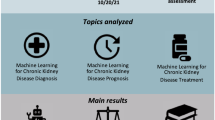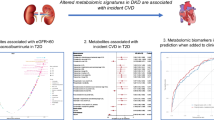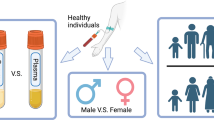Abstract
Background
Renal cell carcinoma (RCC) is the most common and lethal malignancy of the kidney. Distinguishing RCC from benign renal tumors and healthy controls is still a clinical challenge. Urine metabolomics has been used to identify biomarkers of clinical diseases.
Methods
In the present study, we explored the urine metabolomes of a cohort of 61 patients with renal tumors (39 RCC and 22 benign renal tumors) and 68 healthy controls using liquid chromatography coupled with high-resolution mass spectrometry (LC–MS).
Results
Metabolic profiling of urine could significantly differentiate RCC from healthy controls and benign renal tumors. Metabolic pathways, including lysine metabolism and phenylalanine metabolism, were found to be disturbed in the RCC group. Steroid hormone biosynthesis was significantly different between the benign tumor group and the RCC group. RCC biomarkers were further explored. A metabolite panel consisting of cortolone, testosterone and L-2-aminoadipate adenylate was discovered to have good ability of distinguishing RCC from benign tumors, with an AUC of 0.868 for tenfold cross-validation and 0.873 for the validation group. In addition, the panel of aminoadipic acid, 2-(formamido)-N1-(5-phospho-d-ribosyl) acetamidine and alpha-N-phenylacetyl-l-glutamine could distinguish the RCC group from the healthy control group, with an AUC of 0.841 for tenfold cross-validation and 0.894 for the validation group.
Conclusions
This pilot study suggests that urine metabolomics may be useful in differentiating RCC from healthy controls and benign renal tumors.




Similar content being viewed by others
References
Linehan WM, Srinivasan R, Schmidt LS (2010) The genetic basis of kidney cancer: a metabolic disease. Nat Rev Urol 7(5):277–285
Siegel RL, Miller KD, Jemal A (2016) Cancer statistics, 2016. CA Cancer J Clin 66(1):7–30
Bhatt JR, Finelli A (2014) Landmarks in the diagnosis and treatment of renal cell carcinoma. Nat Rev Urol 11(9):517–525
Kind T, Tolstikov V, Fiehn O, Weiss RH (2007) A comprehensive urinary metabolomic approach for identifying kidney cancer. Anal Biochem 363(2):185–195
Kim K, Taylor SL, Ganti S, Guo L, Osier MV, Weiss RH (2011) Urine metabolomic analysis identifies potential biomarkers and pathogenic pathways in kidney cancer. OMICS 15(5):293–303
Monteiro MS, Barros AS, Pinto J, Carvalho M, Pires-Luis AS, Henrique R, Jeronimo C, Bastos ML, Gil AM, Guedes de Pinho P (2016) Nuclear magnetic resonance metabolomics reveals an excretory metabolic signature of renal cell carcinoma. Sci Rep 6:37275
Monteiro M, Moreira N, Pinto J, Pires-Luis AS, Henrique R, Jeronimo C, Bastos ML, Gil AM, Carvalho M, Guedes de Pinho P (2017) GC–MS metabolomics-based approach for the identification of a potential VOC-biomarker panel in the urine of renal cell carcinoma patients. J Cell Mol Med 21:2092–2105
Falegan OS, Ball MW, Shaykhutdinov RA, Pieroraio PM, Farshidfar F, Vogel HJ, Allaf ME, Hyndman ME (2017) Urine and serum metabolomics analyses may distinguish between stages of renal cell carcinoma. Metabolites 7(1):6
Liu XC, Liu X, He L, Zhang W, Wang Y, Sun W, Ji Z (2018) Investigation of the urinary metabolic variations and the application in bladder cancer biomarker discovery. Int J Cancer 143(2):408–418
Gika HG, Theodoridis GA, Wingate JE, Wilson ID (2007) Within-day reproducibility of an HPLC–MS-based method for metabonomic analysis: application to human urine. J Proteome Res 6(8):3291–3303
van Erkel AR, Pattynama PM (1998) Receiver operating characteristic (ROC) analysis: basic principles and applications in radiology. Eur J Radiol 27(2):88–94
Tan Y, Yin P, Tang L, Xing W, Huang Q, Cao D, Zhao X, Wang W, Lu X, Xu Z et al (2012) Metabolomics study of stepwise hepatocarcinogenesis from the model rats to patients: potential biomarkers effective for small hepatocellular carcinoma diagnosis. Mol Cell Proteomics (MCP) 11(2):111010694
Alrob OA, Sankaralingam S, Ma C, Wagg CS, Fillmore N, Jaswal JS, Sack MN, Lehner R, Gupta MP, Michelakis ED et al (2014) Obesity-induced lysine acetylation increases cardiac fatty acid oxidation and impairs insulin signalling. Cardiovasc Res 103(4):485–497
Bres V, Kiernan R, Emiliani S, Benkirane M (2002) Tat acetyl-acceptor lysines are important for human immunodeficiency virus type-1 replication. J Biol Chem 277(25):22215–22221
Sun GD, Cui WP, Guo QY, Miao LN (2014) Histone lysine methylation in diabetic nephropathy. J Diabetes Res 2014:654148
Atanassova SS (2014) Influence of the lysine on the calcium oxalate renal calculi. Int Urol Nephrol 46(3):593–597
Verzola D, Fama A, Villaggio B, Di Rocco M, Simonato A, D’Amato E, Gianiorio F, Garibotto G (2012) Lysine triggers apoptosis through a NADPH oxidase-dependent mechanism in human renal tubular cells. J Inherit Metab Dis 35(6):1011–1019
Lin L, Huang Z, Gao Y, Yan X, Xing J, Hang W (2011) LC–MS based serum metabonomic analysis for renal cell carcinoma diagnosis, staging, and biomarker discovery. J Proteome Res 10(3):1396–1405
Gerlo E, Van Coster R, Lissens W, Winckelmans G, De Meirleir L, Wevers R (2006) Gas chromatographic-mass spectrometric analysis of N-acetylated amino acids: the first case of aminoacylase I deficiency. Anal Chim Acta 571(2):191–199
Basu S, Dasgupta PS (2000) Role of dopamine in malignant tumor growth. Endocrine 12(3):237–241
Papadopoulos EI, Petraki C, Gregorakis A, Chra E, Fragoulis EG, Scorilas A (2015) l-DOPA decarboxylase mRNA levels provide high diagnostic accuracy and discrimination between clear cell and non-clear cell subtypes in renal cell carcinoma. Clin Biochem 48(9):590–595
Jakse G, Muller-Holzner E (1988) Hormone receptors in renal cancer: an overview. Semin Surg Oncol 4(3):161–164
Chen L, Weiss FR, Chaichik S, Keydar I (1980) Steroid receptors in human renal carcinoma. Isr J Med Sci 16(11):756–760
Ludwig JA, Weinstein JN (2005) Biomarkers in cancer staging, prognosis and treatment selection. Nat Rev Cancer 5(11):845–856
Yuan W, Zhang J, Li S, Edwards JL (2011) Amine metabolomics of hyperglycemic endothelial cells using capillary LC–MS with isobaric tagging. J Proteome Res 10(11):5242–5250
Ganesamoni R, Bhattacharyya S, Kumar S, Chauhan A, Mete UK, Agarwal MM, Mavuduru R, Kaushik G, Mandal AK, Singh SK (2012) Status of oxidative stress in patients with renal cell carcinoma. J Urol 187(4):1172–1176
Karoum F, Chuang LW, Mosnaim AD, Staub RA, Wyatt RJ (1983) Plasma and cerebrospinal fluid concentration of phenylacetic acid in humans and monkeys. J Chromatogr Sci 21(12):546–550
Funding
This work was supported by National Basic Research Program of China (nos. 2013CB530805 and 2014CBA02005), the Key Basic Research Program of the Ministry of Science and Technology of China (no. 2013FY114100), the National Natural Science Foundation of China (nos. 30970650, 31200614, 31400669, and 81371515), Beijing Natural Science Foundation (no. 5132028), CAMS Innovation Fund for Medical Science (2017-I2M-1-009) and Biologic Medicine Information Center, National Scientific Data Sharing Platform for Population and Health.
Author information
Authors and Affiliations
Corresponding authors
Ethics declarations
Conflict of interest
The authors declare no conflict of interests.
Ethical approval
All procedures performed in studies involving human participants were in accordance with the ethical standards of the institutional and/or national research committee and with the 1964 Helsinki Declaration and its later amendments or comparable ethical standards.
Informed consent
Informed consent was obtained from all individual participants included in the study.
Additional information
Publisher's Note
Springer Nature remains neutral with regard to jurisdictional claims in published maps and institutional affiliations.
Electronic supplementary material
Below is the link to the electronic supplementary material.
Rights and permissions
About this article
Cite this article
Zhang, M., Liu, X., Liu, X. et al. A pilot investigation of a urinary metabolic biomarker discovery in renal cell carcinoma. Int Urol Nephrol 52, 437–446 (2020). https://doi.org/10.1007/s11255-019-02332-w
Received:
Accepted:
Published:
Issue Date:
DOI: https://doi.org/10.1007/s11255-019-02332-w




